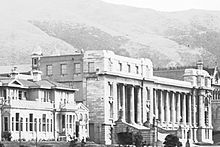Parliament House, Wellington
[2] It was deliberately designed to display New Zealand materials; the building is faced with Tākaka marble, with a base course of Coromandel granite.
[3] Major architectural features of the building exterior include a colonnade lining the front and a long set of steps leading to the main entrance.
The chamber has rimu-panelled walls and, in commemoration of the colour scheme of the British House of Commons, the leather seats and carpets are green.
Featuring a pūriri canopy and Italian marble columns, the chamber's red carpets pay tribute to the colour scheme of the House of Lords (its British counterpart).
[14] The outbreak of World War I created labour and material shortages that made construction difficult, and the choice of Tākaka marble added a logistical challenge to the building process.
[12] During the construction of the building, in 1915, a statue of Richard Seddon (a former prime minister who died in office in 1906) was erected 25 metres (82 ft) east of the main entrance steps.
[12] The renovated building was officially opened in November 1995 by Elizabeth II, Queen of New Zealand, after its comprehensive strengthening and refurbishment.
[12] The intention of the Liberal Government had been for the design to be implemented in stages, eventually resulting in a coherent architectural setting.
Instead, as Heritage New Zealand remarks, the setting that has been achieved "has little aesthetic or architectural coherence", especially through the construction of the Beehive instead of completion of Parliament House.
[20] Access to the public galleries above the debating chamber is not part of the tour, is only possible on days the house is sitting, and a dress code applies.


